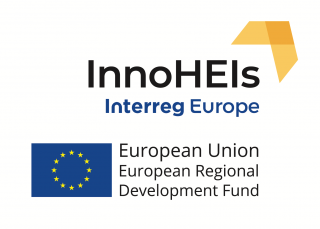TAMK’s InnoHEIs project team is delighted that the objectives of the international project have been met and exceeded. This has also been noted by the European Commission, which has praised the project.
“We have had some quite innovative approaches. We hope that the good work will continue even after the project comes to an end. The Commission has also expressed the hope that this important issue will continue to be developed in European higher education institutions,” says Project Manager Hanna-Greta Puurtinen.
TAMK has been an active member of the European Network of Living Labs (ENoLL) since 2009. ENoLL’s activities are also strongly linked to the InnoHEIs project. The network strengthens the use of living labs provided by higher education institutions. Living Labs can solve big and small problems for businesses, anticipate needs and find new opportunities while facilitating demonstrations and pilots in real life settings.
“We use the ENoLL network to learn, exchange good practices and deepen cooperation with businesses and stakeholders. In this project, the Council of Tampere Region has been an important partner,” says Puurtinen.
The project also gave numerous new inputs to the lecturers.
“This first Interreg Europe funded project in TAMK has provided a lot of learnings in many ways. This new funding instrument and the activities included within opened up the idea that we can in practice influence a regional policy instrument such as the European Regional Development Funds (ERDF). We already have ideas for the future,” says Petri Pohjola, Senior Lecturer from TAMK’s School of Industrial Engineering.
Pohjola’s colleague Timo Rainio fully agrees.
“It has been great to see that through project activities, both TAMK and us teachers have the opportunity to have an impact at regional and national level.”
Tampere Region’s research environments are now brought together
There are dozens of different research, development, innovation and learning environments in Tampere Region’s educational institutions and companies. TAMK’s project team was even a bit surprised by their high number. Consequently, the project team made a mapping exercise and network description of the environments and the services they offer. The innovation situational picture will be maintained by the Council of Tampere Region after the end of the project.
The virtualisation of environments became topical with the introduction of the coronavirus. The virtualisation made the work easily visible in two ways.
“We created a virtual 360 model of the research environments, which is also part of their presentation online. A natural-feeling experience was made possible by augmented reality. At the same time, we also made visible the industrial XR expertise that exists in our region. Virtualisation became almost a standard and attracted interest in project’s European partners,” Pohjola says.
Additionally, the team contributed to the creation of SIXLabs Playbook, an online guidebook to access research and innovation infrastructures and their services in the Tampere Region. This practical playbook explains how labs can be used effectively from the perspective of both research infrastructure providers and their customers.
The team members have also been involved in Tampere Region’s digital compass work, where different levels of education and regional actors cooperate to promote digitalisation within and between all fields and sectors.
“We took the best practices up to the Interreg Europe good practice portal and wrote several articles and other publications,” says Puurtinen.
Joint research and innovation environments will continue to be developed towards the future
In addition to the many outputs already accessible today, the project also generated longer-term impact. Applied research is a strategically important activity for universities of applied sciences. The integration of projects and teaching was well encapsulated in InnoHEIs project. The manufacturing industry lab, TAMK FieldLab, has been a key pilot site for the project.
“This has been a learning environment for us as well. TAMK FieldLab received a good boost and new equipment was purchased. We created and enabled things that we can take into the classroom. Regional and international networks help in teaching, and benefit students more broadly”, says Rainio.
In Tampere Region, the development and better use of research, innovation and learning environments has been implemented over the years in several projects with different funding sources. The project family has approached the development work from different angles to provide companies and SMEs with the most concrete help for their R&D and commercialisation needs. Through InnoHEIs, TAMK has also raised the profile of industrial infrastructure.
Pohjola points out that Interreg Europe funded projects often operate at the top level. However, this project did not want to be limited to the EU regional policy and guidance level.
“We have developed a policy instrument, but we have also taken into account the stakeholders. As a university of applied sciences, we have brought grassroots expertise and knowledge of how the regional policy instrument affects practice. The distance between these two has been bridged and eye-opening discussions have taken place in many directions. This bodes well for the future.”
“Improving Research and Innovation Infrastructure Performance: from Fragmented to Integrated and Sustainable Cooperation” (InnoHeis) aims to expand the role of Higher Education Institutions (HEIs) and the use of Research and Innovation Infrastructure (RII) in regional innovation. The project is coordinated by Hanze University of Applied Sciences. The partners are TAMK and Council of Tampere Region, and the international actors are Northern Netherlands Province Alliance, Autonomous University of Barcelona, DEV’UP Centre-Val de Loire, Mid Sweden University, Ministry of Education & Science of Lithuania, Lithuanian Innovation Center, University of Silesia in Katowice, and Marshal’s Office in Silesia. The project runs from 1.8.2019 to 31.7.2023.
Further information:
Hanna-Greta Puurtinen
InnoHEIs Project Manager
Development Manager | Project Management Office
Tampere University of Applied Sciences
hanna-greta.puurtinen@tuni.fi, +358 50 373 2947
Text: Hanna Ylli
Photo: InnoHEIs project



